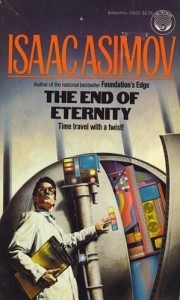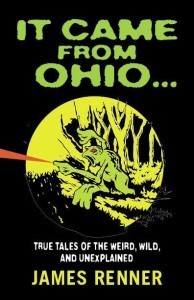James Renner's Blog, page 11
January 16, 2013
Read This… The End of Eternity, by Isaac Asimov
 I love going back to the classics. It’s fun to see what inspired modern-day novelists and screenwriters when they were kids. The End of Eternity, by Isaac Asimov, surely inspired cool stories like The Adjustment Bureau, Fringe, 12 Monkeys, Looper, and Primer.
I love going back to the classics. It’s fun to see what inspired modern-day novelists and screenwriters when they were kids. The End of Eternity, by Isaac Asimov, surely inspired cool stories like The Adjustment Bureau, Fringe, 12 Monkeys, Looper, and Primer.
Check it out: the story is told from the perspective of an “Observer” whose job it is to tweak history so that the aggregate majority of humans live in the highest achievable state of happiness. Just outside of Time is this place called Eternity, where numerous, emotionless monk-like middle management types toil away in an office complex, plotting reality changes to history. Observer Andrew Harlan actually becomes one of the trusted “Technicians” who must figure out the minimal changes necessary to put Time on the right course.
Of course Harlan then encounters a young woman whose existence causes him to question the ethics of what he is doing.
This has everything we’ve come to love about time travel stories: cool machines, mind-numbing paradoxes, and philosophical discussions about the power of “intention” — and it was written in 1955! Ultimately, though, it remains a very tight story about the education of Harlan. His gal breaks it down for him in the end: “In ironing out the disasters of Reality, Eternity rules out the triumphs as well. It is in meeting the great tests that mankind can most successfully rise to great heights.”
There is also quite a nice twist ending I don’t want to spoil, involving a Galactic Empire. Trust me, it fits. It’s short and sweet so check it out.
January 7, 2013
A Dangerous Man Remains Free
 I write about crime. Murder. Serial killers.
I write about crime. Murder. Serial killers.
I started as a journalist, investigating the 1989 unsolved abduction and murder of Amy Mihaljevic. Wrote a book about it. Spent years researching similar crimes across Ohio. I wrote a novel last year, The Man from Primrose Lane, about a reporter who tries to solve a murder only to discover the truth lies within the twisted history of his own family.
My favorite part of the job is when I’ve tracked down a suspect in a murder who still lives free and I get to go knock on his door. I get to tell him I know his secret and even though he’s managed to avoid jail, I get to put his name in print for everyone to see. I get to scare them.
I once flew to Key West on my own dime to confront a suspect in the Mihaljevic case.
Yesterday, I dropped by a house on North Union in Alliance, Ohio. It’s a two-story surrounded by a high fence, fortress-like. A handsome old man with wispy white hair lives there. He’s the most dangerous predator I’ve ever discovered. His name is Keith Simpkins. He came outside to talk with me.
“Do you remember me?” I asked.
He crinkled his eyes and smiled but shook his head. “I should. I know that. I do know you. But I can’t place it.”
“I’m James Renner,” I told him. “Last time you saw me I was a kid. I grew up and now I’m a writer. And I came by to let you know I’ll be writing about you on Monday.”
“You’re Jimmy,” he said, eyes wide.
I nodded. “I’m your grandson.”
My mom thought her father was dead for many years. Before she was old enough to have many memories of him, he disappeared. The story was he died in a car crash on 7-hill road coming back from the bars. Her mom took her and her three sisters to live with family on a farm in the country south of Ravenna. Around the time she met my father in 1975, she discovered her old man was still alive and had started a new family in Alliance. She had two brothers and a sister she’d never met.
My aunt, “A,” was twelve when she left the farm to go stay with Keith in Alliance. He gave A her own room and a new bike. She felt like a girl in a fairytale who finds out she’s an orphaned princess. Keith was damn near perfect. Active in the church. A leader in the local Boy Scout troop. A mentor at A.A.
Six months later, Keith was raping her every day. He’d ply her with booze and pot and then tie her to the bed and gag her mouth so she wouldn’t make a sound when it hurt. Sometimes it happened after school. But most times it was at night when everyone else was in bed. She could hear him coming down the hall because he whistled to himself on the way to her room.
On Saturdays, he would take A to Acme Hard Chrome (now Acme Industrial Group, on Freedom Street) where he chrome-plated metal, and rape her in his office.
Once, when A hosted a birthday party at the house, Keith went after one of her friends. The girl called her parents and left and avoided A the rest of the time she was at school.
“I turned him in to the school counselor at Stanton Middle,” she recalls. “I showed the bruises all up and down my thighs. They called him and brought him into the room with me and he denied it. Said I was just a hood kid trying to cause trouble.”
My aunt B tried to protect the others. She’d made a pact with Keith that she wouldn’t resist when he raped her so long as he never went after her younger sisters. She didn’t find out until later that he lied to her too.
A couple years later, Keith started raping his daughter “V,” too. V says she remembers how it was before he disappeared when they were toddlers. Back then, he’d been content just making her watch.
As a kid, I never knew any of this. My mother suspected, probably, but had no first-hand knowledge (other than the time he got drunk and told her in a strange voice how much she looked like her mother when she was young) and so I spent a lot of time at his house on North Union with my little sister. Holidays, mostly. Sundays for football on occasion. His kitchen always smelled like boiled hotdogs, or sloppy joes and coffee. We were never left alone with him. I still walk the layout of his house in my dreams, the framed painting of the man praying in the living room, the Saturday Evening Post in the bathroom upstairs.
I remember he had a dog that could talk. It said “Momma,” and “I love you.” Sometimes he would invite the older kids to watch marathons of Rocky movies in the basement and I couldn’t wait for the day when he would invite me.
We were pen pals. He was a storyteller. He’d write me long stories, most of them funny, on tall sheets of yellow legal paper.
Then one day in 1989, my mother told me, simply, that my grandfather was a very evil man and that we would never see him again. The sisters, my aunts, had finally started sharing their stories with each other. And now their own children were old enough to catch Keith’s attention and there were far too many of us to keep an eye on. They had to cut ties before he started raping his grandkids. And that meant they couldn’t deny it anymore.
This revelation changed each of us in different ways. Most of us just had this weird empty spot in their family tree that was hard to explain to curious friends. Odd, but nothing tragic, right? My aunts, though, had to explain to their husbands why they were cutting off contact with their father. And that meant taking a good hard look at how fucked up their life was because of this one man. They were less able to assimilate this news because of the alcoholism, drug abuse, and physical deteriorations caused by years of the abuse Keith dealt to them. This revelation caused divorces. Mental breakdowns. A nuclear bomb had gone off, irradiating fucking everything. And the worst part was that Keith remained unharmed, clean, a respected member of society in the small town of Alliance. He even had the audacity to get sober.
But he never stopped his predation.
My uncle Michael lived with Keith back then. He was about 14 and I was 7 when I was still going over there regularly. Michael had a stop sign on his bedroom door which I thought was pretty badass (but, I realize literally as I’m writing this, how that sign was probably a not-so-subtle plea to his father). Michael taught me how to play Othello in his room one day. I thought he was the coolest.
Michael contacted me last week. I hadn’t seen him in 24 years. We met over pizza at Luigi’s in Akron. The dining room was full and it was hard to keep our discussion quiet. Several people looked over with shocked expressions during the course of that hour.
“His thing was to perform masturbation rituals on me, in my presence—orally stimulate my penis to force me to have an erection, that’s how he would get me to have anal sex with him,” says Michael. “His favorite location for these situations was in the basement of our house. There was a putrid blanket covered with dog fur that they kept in front of the door—that was our dog Rebel’s bed. He would shoo the dog away and want sex there a lot. He concentrated in that area, would venture into my bedroom occasionally when the coast seemed clear to him. There were times that I knew my mother was in the house upstairs when this was occurring—I believe she was completely aware on some level that this was occurring, but was either too indifferent to my situation, or did not feel compelled to intervene.
Sometimes, instead of raping him, Keith would ask him to undress. Then he would beat him senseless. That got his rocks off, too.
“I’ll never forget the rancid smell of his sweat, cheap hand cream, mingled with acrid smoke of menthol cigarettes he would smoke while masturbating. He has a very unusual body mark, or a scar on the tip of his penis that I remember vividly. It was very noticeable when he had an erection and since he frequently stuck it in my mouth, yea—I got a good look at it. The scar came out of the hole and down the head—just really weird.
“I remember being about age 14 when this was over, when I had considered castrating myself—I think I had the knife ready and was kind of looking for a way to commit suicide. That summer was rough for me, to say the least. I very nearly did it. But my story took a turn for the better—it was soon after that I met a girl and she showed me that I could be loved. She gave her heart to me and when I was with her, I didn’t feel like a freak, I felt good about myself. She was my first love—gets complicated. But, that is the basic narrative.”
Michael confronted his parents a few years ago after he had his second child. He told Keith he could still have contact with his grandsons but he would never be alone with them. Michael’s only condition: Keith had to admit the abuse. His parents cut off all ties with him, instead. Then, years ago, now, Keith sent him a card. He had stage-four colon cancer and probably wouldn’t live soon.
“Still trying to manipulate me,” says Michael. “Still trying to control the situation, find a way to get me back.”
“What side of the fence are you on?” my grandfather asked me on the porch of his house in Alliance.
I don’t tell him that my five-month-old daughter inherited his red hair and that I have to think about him every time someone asks about it.
“You need to go away,” I said. “But I was curious if you’d admit it first.”
“I’ve done some terrible things in my life,” he said. “But I’m in the church. I’m doing better. I’m a better man.”
“Okay.”
“This is a bad time for me.”
“Would there be a good time for this story?”
“You don’t understand, Jimmy. I just found out I have stage-four colon cancer. I probably don’t have much time left.”
“Would you do me a favor?” I asked. “Please write down everything you did so we have it when you’re dead.”
He nodded. “I’ve written some things already.”
Last year, my aunt V contacted a police detective and tried to press charges against Keith. But some rich men have put restrictions on prosecuting rape cases in the state of Ohio. You’ve got to file within 20 years. Here’s the thing, though—rapists screw up their victims so much it usually takes more than 20 years to get healthy enough to take them on. Even Michael’s assaults took place beyond the 20-year threshold. But he still maintains contact with some of his children. And their children. And no one believes he’s ever stopped.
We’re concerned there are also victims outside the family.
I’m concerned because my grandfather exhibits a very special and rare combination of behaviors that are shared by the killers I like to hunt. He’s a sexual sadist who enjoys not just the control he has over his victims but also the physical pain he administers through his rapes and beatings. He’s highly intelligent and organized. And he knows how to manipulate children.
We have no pictures of him. He didn’t like his picture taken. But he’s always had the same fine head of white/red hair and a bushy red mustache. He would be about 75 years old, today.
UPDATE: Here he is.
If you have information that can lead to the arrest of my grandfather, please contact Alliance Police at 330-823-5383.
December 19, 2012
Go See This… The Hobbit 3D at 48fps
 Caught a screening of The Hobbit at Valley View in Cleveland last night. This is the only place in NE Ohio where you can see it in 3D at 48 frames per second, in XD sound, the way God and Peter Jackson intended. A single ticket sets you back $14. But is it worth it? What is 48fps really like? Here are my impressions the morning after.
Caught a screening of The Hobbit at Valley View in Cleveland last night. This is the only place in NE Ohio where you can see it in 3D at 48 frames per second, in XD sound, the way God and Peter Jackson intended. A single ticket sets you back $14. But is it worth it? What is 48fps really like? Here are my impressions the morning after.
Remember that scene in The Prestige where Hugh Jackman shows off his Tesla transporting machine for the first time and that old stage producer is sitting there and kind of jumps in fright when old Hugh disappears and then reappears behind him? The old man says, “Forgive me. It’s been so long since I’ve seen real magic.” And then he warns him to “dress it up” a bit so the audience can still pretend it’s just illusion. That’s pretty much what it was like.
All the critics and nerds whining about how the 48fps makes the film look fake have it wrong. It makes it look too real. More than you’re ready for. For me, it felt like I was at Hale Farm and Village, that Civil-war era community they took us to in gradeschool. It felt like I was immersed in a artificial setting watching people act out a scene around me. It’s so real you become aware of the characters in a way we are not used to. And that’s the best way I can explain how it feels. It feels more like a stage production than any film you’ve ever seen. But that’s not bad, in my opinion. It’s just a different experience. It might be film but it’s not a MOVIE and it shouldn’t be called one. This is something new. So new, there is no name for it.
You know what would really be fucking cool in 48fps? A courtroom drama. Something like 12 Angry Men. Something where you’ve got real people in a real, tight situation. That’s how they should have introduced 48fps because it’s so goddamn real it messes with your mind when you see things like fighting rock giants and trolls and orcs. The immersiveness of the experience is telling you, holy shit, that’s a real goddamn goblin. But your mind is too smart for that. It insists it can’t be real. And then you’re spending all this time fighting with yourself. It kind of pulls you away from it.
For all its faults, you owe yourself to go see this movie in 48fps/3D. It will remind you of how you believed in real magic when you were a kid.
November 28, 2012
Read This: Gone Girl, by Gillian Flynn
 You don’t really need me to tell you to read Gone Girl. It’s this year’s “Girl with the Dragon Tattoo,” with all the appropriate zeitgeist.
You don’t really need me to tell you to read Gone Girl. It’s this year’s “Girl with the Dragon Tattoo,” with all the appropriate zeitgeist.
But if you’ve been hiding under a rock, here’s what it’s about: you know those stories you see on the news all the time? The ones where the pretty young wife disappears and the husband starts acting all suspicious? Yeah, it’s that story. For the first half, anyway. Then, oh my lanta! Then the novel becomes somethings else — a thriller in the tradition of Hitchcock, full of wonderful melodrama.
Having a little experience with novels that take a sudden, jolting turn hundreds of pages in, I understand how difficult this book must’ve been to get published. Gillian, her agent, her editor, her publisher all deserve a pat on the back (and a raise!) for taking such a risk. As a reader I love this kind of mind-fuckery. There’s not enough of it in the literary world–and make no mistake, Gillian is literary, even if she’s hiding behind genre. Here’s one of my favorite sentences: “Maybe it was my conscience, scratching back to the surface from its secret oubliette.” That’s literary.
I had the pleasure of meeting the writer at a book fair in Ohio last month. She signed it for my wife, “To Julie, from her sweet husband.” After reading the book, I have to wonder if that wasn’t some sly joke.
To say anymore would be to ruin the book’s surprises. Just read it already.
November 11, 2012
Read This: Zone One, by Colson Whitehead
 So someone went and wrote a literary novel about the zombie apocalypse. Kind of the Ulysses of flesh-eating fiction.
So someone went and wrote a literary novel about the zombie apocalypse. Kind of the Ulysses of flesh-eating fiction.
The plot is sparse. Such as it is, the narrative follows a young man called Mark Spitz and the two other members of his survivalist unit as they comb through lower Manhattan killing straggler zombies in an effort to reclaim the city, or at least safeguard Zone One. But we see much of the world through flashbacks which take us from First Night to the present day. The longer we stay with Spitz and his company, the more we learn about their past.
I guess the chief complaint from bloggers about this book is how it constantly jumps from this present to flashback, sometimes mid-paragraph–and it can be jarring at times. My wife is a serious fan of post-apocalyptic novels and she gave up after twenty pages. Partly because of the non-linear structure, but also because this story is DENSE. Colson is a word fetishist and does not make it easy for the reader. The dude would be no fun to play Scrabble with.
I LOVED the book, though. LOVED it. It’s dreamy. It’s stream-of-consciousness almost. A fever dream of a vision of our nightmares. Mark and his friends are fully formed and we learn a lot about the human condition (and the message, here, is strangely hopeful) in the little scenes when death approaches in the form of the endless undead army.
Take your time with this one. It’s worth it.
November 5, 2012
Read This: My Friend Dahmer, by Derf

My Friend Dahmer
The artist mostly known as “Derf” was a bit of a mystery during my tenure at the Cleveland Scene and Free Times. He was the guy behind the coolest comic strip in the paper, The City, which ripped on Cleveland every week but also seemed to celebrate its crazy residents at the same time. I would occasionally see him at company parties, quietly watching from the back, this tall dude with a long face who usually seemed pissed at something.
There was this rumor he’d been friends with the serial killer Jeffrey Dahmer in high school. I’d never doubted it. But I was a little surprised when he dared to turn his artist’s eye to that part of his life. It would be tempting for any storyteller, sure, but in order to go there you have to show Dahmer as a sympathetic character. Because he was, after all, human. And a friend to some people. And would readers really want to go there?
Earlier this year, Derf finally got around to telling his story in My Friend Dahmer, a thick, gorgeous graphic novel that presents the cannibal killer as a tragic character, someone who might been saved even, if only one fucking adult had bothered to wonder why Jeffrey was acting so strangely and had cared enough to get him some help. Dahmer did not go quietly into full-on sociopathic insanity. The signs were there — animal mutilations, binge drinking at 15, a shocking lack of empathy for fellow human beings — and they were hard to miss. It’s like watching Anakin turn into Darth Vader, only slowly and with no definable event to motivate the fall.
The book covers Dahmer and Derf’s last years of high school in bucolic Bath, Ohio, one of the safest neighborhoods in the state. And by the end of the summer following their senior year, both have discovered their passion — Derf has become a fledgling artist, Dahmer a practicing psychopath and murderer. Drawn in high-def contrast, with his slightly-grotesque portrayal of the human form, this book serves as the universal countering force of Dahmer’s own dark obsession. The art’s creation only made possible as a result of the acts it chronicles and the effect it had on the artist.
In summation: way cool.
October 23, 2012
Listen to this: The Turn of the Screw, by Henry James
 Drove out to Manhattan last week to speak with my editor about a new novel (more on that soon). The trip is a rough seven hours East on I-80 and there was a lot of time to burn. I made some use of it by downloading a couple audio books over at Audible, the company that did a sweet job on The Man from Primrose Lane.
Drove out to Manhattan last week to speak with my editor about a new novel (more on that soon). The trip is a rough seven hours East on I-80 and there was a lot of time to burn. I made some use of it by downloading a couple audio books over at Audible, the company that did a sweet job on The Man from Primrose Lane.
I brought two books along with me. The first was Defending Jacob, which was a murder mystery that came highly recommended. It was well written and well told. But in the end, little more than grief porn and parental paranoia. Not my thing. The other story, though, was a classic: The Turn of the Screw, published in 1898. And its mood and tone fit perfectly well with the New England autumn backdrop.
The yarn begins the way so many good old stories do, with a character coming forth to explain why this story he’s about to tell you is the most depraved, most frightening thing you’ve ever heard. Lovecraft does this a lot, this circus barking to ramp up suspense. We’ve somehow lost this over the last hundred years, with most editors and writers preferring to just get us right into the story as if they’re embarrassed to sell it too much. Which is a shame, because it really does add a keen sense of suspicion.
Simple story, well done. A young woman applies to become the governess of two children who live on a country estate. The last governess died under mysterious circumstances and may be haunting the place. That’s about it. But the execution is lyrical, wonderful. James slowly turns the screw until the sense of dread about Bly manor is palpable. And he’s daring enough to leave any real explanation to the reader. Is the woman going crazy? Or are the ghosts real? Oh, and it packs a hell of a wallop in one last sentence.
If you pick up a copy, put in on the shelf between Jane Eyre and Rebecca. But I recommend going the Audible route and heading out for a long road trip. Somewhere desolate and cold.
October 7, 2012
Help us make a film about the search for Amy’s killer.
Since I was 11, I’ve been searching for the man who abducted and murdered Amy Mihaljevic. I’ve written a book about it. And I maintain a blog where I keep updated info on clues and suspects.
But there are some things I would like to say about this mystery which really only work in a visual medium. I’ve thought for awhile about making a feature film and with the renewed interest in her case, now seems like the best time to get started.
Two days ago, I launched a fundraising effort through Indiegogo, where you can help produce this project for as little as $10.
Check it out.
October 2, 2012
Hot off the presses!
 It Came from Ohio has arrived, just in time for Halloween! Learn all about Ohio’s creepiest legends: The Loveland Frog monster; the Melon Heads of Kirtland; the flying saucer that attacked a helicopter over Mansfield; an elite secret society run by Bob Serpentini; and more… Copies are being distributed to area bookstores. Be sure to visit the independents.
It Came from Ohio has arrived, just in time for Halloween! Learn all about Ohio’s creepiest legends: The Loveland Frog monster; the Melon Heads of Kirtland; the flying saucer that attacked a helicopter over Mansfield; an elite secret society run by Bob Serpentini; and more… Copies are being distributed to area bookstores. Be sure to visit the independents.
If you like ebooks, you can pick it up for $3.99 for your Nook or Kindle. You can also order the paperback through Amazon and Barnes & Noble.
And if you like free stuff, you can enter to win a copy through Goodreads!
September 14, 2012
Meet the new book: It Came from Ohio!
 So remember that part in The Man from Primrose Lane where the cop encounters a half-man/half-frog with a spark wand on the back roads of Loveland, Ohio? Believe it or not that’s based on a real incident that occurred near Cinci decades ago. The true story of the Loveland Frog appears in my new book, It Came from Ohio! which you can now pre-order by clicking the picture (that’s the Frog on the cover).
So remember that part in The Man from Primrose Lane where the cop encounters a half-man/half-frog with a spark wand on the back roads of Loveland, Ohio? Believe it or not that’s based on a real incident that occurred near Cinci decades ago. The true story of the Loveland Frog appears in my new book, It Came from Ohio! which you can now pre-order by clicking the picture (that’s the Frog on the cover).
It Came from Ohio! is a collection of 13 short investigations I conducted into famous Ohio legends. There’s the story of the Portage County deputies who chased a flying saucer into Pennsylvania, an expose of an elite secret society that owns a private island on Lake Erie which they staff with underage European girls, and other oddities like jealous ghosts and canibalistic mutant children.
The book will be released in October as a paperback and an ebook for all formats. Just in time for Halloween!




